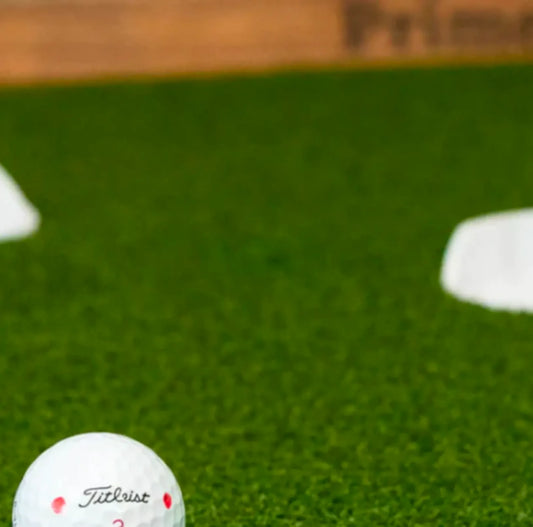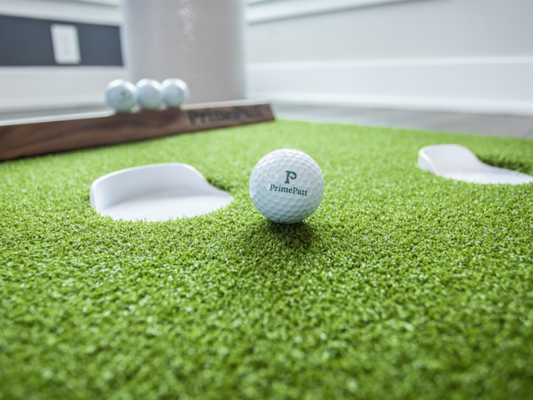Putting skills aren’t acquired overnight, but practicing at home can elevate your short game in no time. Investing in an indoor putting mat allows you to train anytime, whether day or night, rain or shine. No matter your skill level, a putting mat is the perfect tool to refine your putting stroke.
When roughly 40 percent of your golf game is spent putting, it’s critical to put in the time and enhance your putting game. We’ve put together the top ten indoor putting drills to help you build confidence, refine your technique, and ultimately lower your scores. As you practice these drills, you’ll be well on your way to becoming a pro and earning bragging rights among your golf buddies.
The Bottom Line
- Crucial Putting Skills to Practice: Properly rolling puts, stroke, speed control, and sinking putts are all skills that you should spend time on in your free time.
- Top 10 Putting Stroke Drills: Work on these putting drills at home to become more consistent and accurate.
- How to Correct Common Putting Mistakes: If you're having trouble finding your stroke, look out for these common mistakes.
- Time to Drill Down: You can build tour-level confidence with a tour-quality putting mat.
Crucial Putting Skills to Practice
An excellent practice session includes:
- A drill for the technique of the putting stroke.
- Properly rolling putts on the correct line.
- An exercise that focuses on speed control.
- A drill that sees you draining putts often.
- A competitive game where you can put all of these elements together under pressure.
If your time block doesn't allow all five, even a few minutes spent focusing on any of these areas will result in more one-putts.
Top 10 Putting Stroke Drills to Improve Your Short Game
Having solid putting strokes makes a huge difference in your overall golf game. Incorporate these drills into your routine to help you become a more accurate and confident player on the greens.
1. Putting Mirror Practice
First, you need to know whether your stroke works better with a blade or a mallet putter. Utilize a mirror or video to see what your natural putter path is; that will help determine which putting aids will be most helpful for your putting stroke. A putting mirror allows golfers to self-correct their alignment, stance, and ball position. It also helps ensure the putter face is square to the target and flush with the ground at the address. These cues give you confidence that your setup is correct without having an instructor nearby. Without the proper setup, your putting stroke suffers—ask Tiger Woods!
2. Straight-Back Straight-Through Path Putting Stroke Drill
Use an alignment rod placed along the toe of your putter head to practice a straight-back and straight-through stroke. Five to ten minutes of reps with the alignment rod during each practice session will help build the repetitiveness of the stroke and provide instant feedback if it goes off line.
3. Arc Putting Stroke Drill
If your putting stroke is more of a semicircle, a putting arc is more beneficial than a rod to work on your putting stroke. Maintaining the putter's heel along the top edge of the arc will help stabilize the stroke while allowing for more rotation and keeping the putter face square through impact.
4. Ruler or Yardstick Drill
Place a ruler or yardstick on your putting mat, aiming at the hole. Then, place a ball on the flat spot on top of the stick and putt it toward the hole. It seems simple, right? It's much trickier than it looks to keep the ball rolling down the stick without falling off. Challenge yourself to make three putts in a row with the ball staying on the ruler or stick before reaching the hole (using the correct speed).
5. Ball Mark Drill
Place a small sticker or ball mark directly between you and the hole. Take three golf balls and putt them from three feet away. Practicing short putts and rolling each ball directly over the small mark on the same line will help build confidence in starting the ball on the proper path. Keep in mind that there is more than one speed at which you can make a putt. So, matching the speed with the line is imperative for making more putts.
6. Manila Folder Putting Drill
The manila folder putting drill teaches speed control; in fact, it's one of the best out there for it. You only need an indoor putting mat, an office manila folder, and three balls. Start putting from five feet away, and get all three balls to finish on the folder. Then move to eight feet, and roll putts with the same goal. Keep moving back as far as possible to see how many in a row you can get to stop on the folder. This drill can quickly turn into a game by making it a ladder drill or challenging an opponent.
If you have a larger mat and can putt from around the hole, a similar drill without the folder is called the clock drill. As simple as its name indicates, the clock putting drill focuses on speed control and constantly switches up the distance of the first putt and location around the hole.
7. 12 to 18” Distance Control Drill
Place a tee or golf club 12-18" behind the cup, a foot and a half. Place tees or markers at 3, 6, 9, and 12 feet from the hole. Using three golf balls, try to get the ball to stop rolling somewhere between the front edge of the cup and the object placed behind the hole. This exercise teaches distance control, but unlike the manila folder putting drill, putts can actually be sunk. If the ball ends up past the hole but before the object, that's the proper speed!
8. Metronome Drill
Utilizing a metronome app is excellent for controlling ball and putter speeds. The metronome makes a "tick-tock" sound that can speed up or slow down depending on what number it's set at. For repeatable speed control, a skill you need when you're under pressure, you need a consistent putting rhythm. A metronome is also handy for your full-swing practice. What number would Ernie Els' swing be?
9. One-Handed Drill (Tiger Woods Drill)
If you were fortunate enough to see Tiger Woods at a PGA Tour event, you might have witnessed his pre-round warm-up putting routine, which includes the one-handed drill. Woods will putt one-handed with his dominant hand for 12 putts and then re-introduce his non-dominant hand. Woods also pins two tees in the ground along the toe and heel of his putter to make a gate when he does this drill. This practice gives instant feedback on the impact, so you'll know if you hit the ball in the middle of the clubface.
10. Looking at the Hole or Closing Eyes Drill
Looking at the hole or closing your eyes while putting is the last drill in our top 10 for a few reasons. By taking your sense of sight out of practice, the body and putter naturally react to the distance from the hole using pure feel. One of the best putting exercises is to make a good roll toward the target with all feel and touch. It's amazing how much smoother the putting stroke gets by doing this, all while developing your innate sense of touch and feel. This simple putting drill can be used to practice putting from short, medium, or long distances, ideally at random.
How to Correct Common Putting Mistakes with Indoor Drills
During your indoor putting practice, you may make errors that many golfers also encounter. Here are some mistakes to look out for and how to remedy them:
Poor Alignment
Many golfers struggle with correctly aligning their putter face and body, resulting in missed putts. If you're having trouble consistently aligning your shot, try using alignment sticks or a putting mirror. These drills will help you visualize how your body is aligned in relation to your putter over time, which will help you establish proper setup and lead to more accurate putts.
Inconsistent Stroke Length
If you're having trouble determining the proper stroke length for different distances, you can practice making controlled strokes using your putting mat. Place markers set at different distances to help develop a feel for distance control, which you can then adjust as needed. The more familiar you become with putting for specific distances, the better your muscle memory will be for determining the proper stroke length.
Poor Tempo and Rhythm
Your tempo and rhythm are critical for making consistent putts, but they can be difficult to assess on your own. However, devices such as a metronome or other rhythm aids can assist you in developing a natural pace. Set the device to a comfortable tempo and attempt to time your stroke to the beat. Before introducing a ball, you can practice a few test strokes to get a feel for the rhythm that feels best.
Lack of Confidence
Above all, confidence is possibly the most important factor in your short game. If you second-guess your stroke or technique, you won't be able to focus on making a good putt. To increase trust, try drills that involve other people who could bring more enjoyment to your practice, such as friends or family. This could help you break the self-critique and overthinking habit. You can also start small and do tasks you can complete successfully before progressing to more difficult practices.
Time to Drill Down
Clearly, we are obsessed with putting! It's an endlessly fascinating and challenging part of the game of golf. Only utilizing a putting mat to practice making putts is fine, but we suggest breaking down the different skills it takes to become a great putter. By spending time on each skill, you'll become a more complete and confident putter. Better skills lead to better performance on the putting green and, ultimately, more tap-ins and lower scores.
Getting just a little better every day is a goal many top athletes have. Having a focused practice that can travel from the indoor putting mat to the course will set you up to see more putts drop.
As the famed Scottish golfer Willie Park Sr. said, "A man who can putt is a match for anyone." Even if your other golf clubs aren't working their best that day, being able to make the putts you need is so satisfying. Spending time on these drills with a mat that allows you real practice for the real course will result in lower scores and more fun golf. Best of luck!




